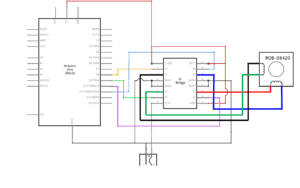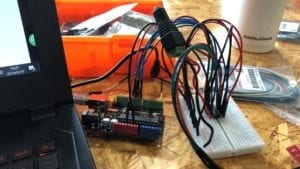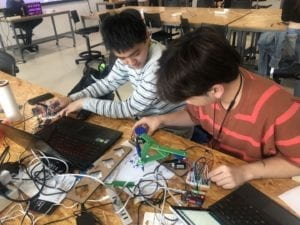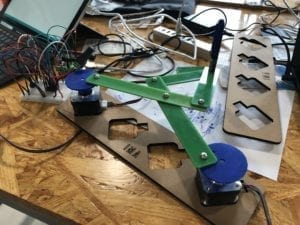Macterials:
Step 1 and Step 2
1 * 42STH33-0404AC stepper motor
1 * SN754410NE ic chip
1 * power jack
1 * 12 VDC power supply
1 * Arduino kit and its contents
Step 3
2 * Laser-cut short arms
2 * Laser-cut long arms
1* Laser-cut motor holder
2 * 3D printed motor coupling
5 * Paper Fasteners
1 * Pen that fits the laser-cut mechanisms
Paper
Process:

sources:https://wp.nyu.edu/shanghai-ima-interaction-lab/category/recitations/
Step1:Build the circuit
I followed this diagram to connect the breadboard and Arduino. But I forgot to connect the two ground pins of ic to ground so the circuit was not a closed circuit. So it didn’t work.
Another question is that I used two wires to connect two sides of breadboard. It was totally wrong. At first I wanted to connect them so that all the I could use both sides of board. But I forgot that 12v power will directly rush to the arduino, which only needs 5v power. The result of it was that the arduino board didn’t light up. I was scared by this because I thoungt that the strong power in 12v destroied my arduino. But luckily, with the help of fellow, I only kept the ground line connection and remove the wire which connected two power lines on breadboard. It finally worked.

Step2: Control rotation with a potentiometer
We went quite smooth in this part. What we only forgot is the map function. Because we didn’t remap the value of rotation from 0 to 1023 to 0 to 255, the my side’s stepper motor rotated too strong, resulting that when it worked, the drawing machine was draged strongly and was destroied by the force of motor. Thanks to the help of Young, we remap the value and we made it.

Step3:Build a drawing machines
When we built the drawing machines, the only problem that we encountered is the paper fastener. They were too fragile. We did not know the reason why we always broke the legs of those paper fastener. We also did not know how to fastened the drawing controling legs of drawing machines. So when the drawing machine worked, it could only maintain about 10s and the was destroied by the force of motor. But it worked.

Question1:
I want to make a automatic shoe-tight machines. Because I love shoes and I realize that sometime I am so lazy to suqart down and tie my shoes. Also, it is hard for the disable to tie shoeslace, especially the people who don’t have arms. The use of actuators is very interesting. I know how the machines in dairly life work by learning the use of actuators. Besides, I can do more engineering works for my project in the future. I am looking forward to using different kinds of acutators for my project in the near future! For manipulation of digital art, I think it is new to me because I never get touch to this field before and I think there is a necessity for me to explore it because I can use this digital art to help the disable and help more people reach to such beautiful things of art more easily. For creative process, I think at least it is hard for me now. I find out that I am hard to generate an excellent idea. I want to be unique and different from others. But it is difficult for me. So recently I just start from observing how the others do and try to get inspiration from them. I hope that in the near future I can do a better job, I can be a designer and creator. I love creating.
Question2:
There is a wooden mirrow projece designed by Daniel Rozin. It is a machines which can transfer to images of users to digital signal, then through computer programming to reflect on wooden mirrow( ART + Science NOW, Stephen Wilson (Kinetics chapter)). The manipulation of digital art in this project is to combine physical appearance of user and physical subject with computer program, showing picture in the color of wood. We have seen several mirrow project before, this one is similar to the previous.
Compared to what we have done in recitation four, this project is more interesting in interaction. The similar parts of this project and our drawing machines is that they all combine the physical things with digital technologise. We can bring technology, which is more conceptual to real life. The differences between them lies in interaction. Daniel’s project is more natural because he “hide” the input of his project–the users only need to stand in front of the wooden mirrow to get feedback. The interactive process is so natural and smooth that people can feel comfortable. Also a sense of magic will be brought to the users. Our drawing machines are just typical manipulating interaction.